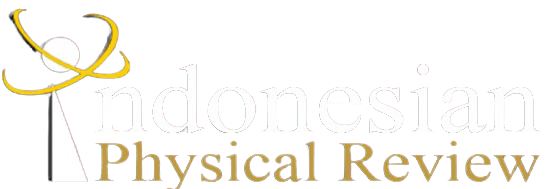ENHANCED PERFORMANCE OF DYE-SENSITIZED SOLAR CELLS USING MELINJO PEEL (GNETUM GNEMON) DYE AS SENSITIZER
DOI:
10.29303/ipr.v2i3.28Downloads
Abstract
It has been successfully identified and characterized by dye Melinjo peel (Gnetum gnemon) as an active material for Dye Sensitized Solar Cells (DSSC). The sample is formed in the structure of a working pair of electrode sandwiches and opposing electrodes. The dye extraction process (Dye) of the melinjo was stirred for 1 hour and then left to stand for 24 hours but there were only differences in how to doping dye into TiO2.Dye-sensitized solar cell (DSSC) is one of the photochemical electrical cells consisting of a photoelectrode, dye, electrolyte, and counter electrode. The purpose of using dyes in the DSSC is to extend the absorption spectrum to visible light because visible light has about 96% energy from sunlight. This article presents some experimental data on the nature of absorbance and the conductivity of natural dyes extracted from the plant as an application in the DSSC. Absorbance test using Spectrophotometer UV Visible 1601 PC and electrical properties test using Elkahfi 100 / Meter I-V. DSSC fabrication has been done using dye extract of melinjo (Gnetum gnemon) with a variety of immersion technique of drops and soak. The results show that natural dyes from natural material extraction have an absorbance spectrum of 380-520 nm range and the greatest conductivity is owned by melinjo (Gnetum gnemon). From the results of the test using AM Simulator 1.5G (100 mW / cm2) diesel simulator, it was found that the volume of TiO2 precursors affected the performance of DSSC solar cells and the overall conversion efficiency was 0.03% for the melinjo (Gnetum gnemon) dye by drops technique and 0.009% for the melinjo (Gnetum gnemon) dye by soak technique.References
Hans-Wilhelm Schiffer. 2016. World Energy Resources. Publishing by the World Energy Council.
Fahhad H. Alharbi, Sabre Kais.2015. Theoretical limits of photovoltaics efficiency and possible improvements by intuitive approaches learned from photosynthesis and quantum coherence. Elsevier: Renewable and Sustainable Energy Reviews 43 (2015) 1073–1089.
Lin T-W., Lin J-R., Tsai S-Y., Lee J-N., dan Ting C-C., 2007, Absorption Spectra Analysis of Natural Dyes for Applications in Dye-Sensitized Nano Solar Cells, The 31st National Conference on Theoretical and Applied Mechanics, December 21-22, 2007, ISU, Kaohsiung, Taiwan, R.O.C.
Grätzel, M., 2006. Photovoltaic performance and long-term stability of dye-sensitized meosocopic solar cells. Elsevier: C. R. Chimie 9 (2006) 578–583.
Grätzel, M., 2003. Dye-sensitized solar cells. Journal of Photochemistry and Photobiology C: Photochemistry Reviews 4 (2003) 145–153.
Gao F. G., Bard A. J., Kispert L. D., 2000, Photocurrent generated on a carotenoid-sensitized TiO2 nanocrystalline mesoporous electrode, Journal of Photochemistry and Photobiology A: Chemistry 130 (2000) 49–56.
M. Akiyama, E. Abe and I. Imai, High efficiency dye-sensitized solar cell based on a nitrogen doped nanostructured titania electrode, vol. 5, 2005, pp. 2543-2547.
J.Halme at al. 2002. Dye-sensitized nanostructured and organic photovoltaic cells: technical review and preliminary tests. Finlandia: Helsinki University Of Technology.
Kalyanasundaram K., Gra¨tzel M., 1998, Applications of functionalized transition metal complexes in photonic and optoelectronic devices, Coordination Chemistry Reviews, 77 (1998) 347 – 414.
Nurussaniah, Anita, Boisandi, 2018. Isolasi Dye Organik Alam dan Karakterisasinya Sebagai Sensitizer. Jurnal Ilmu Pendidikan Fisika: 24-27.
T. H. Meen, C. J. Huang, S. M. Chao, J. K. Tsai, W. Water, W. R. Chen, Y. S. Liu, and L. W. Ji, "Applications of vertically oriented TiO2 micro-pillars array on the electrode of the dye-sensitized solar cell," J. Phys. Chem. Solids, vol. 72, no. 6, pp. 653–656, 2011.
M. Akiyama, E. Abe and I. Imai, High efficiency dye-sensitized solar cell based on a nitrogen doped nanostructured titania electrode, vol. 5, 2005, pp. 2543-2547.
Sanmathi Chavalmane Subbenaik. 2016. Chapter 2 Physical and Chemical Nature of Nanoparticles. Springer International Publishing Switzerland 2016.
Kristina Fischer, Alina Gawel, David Rosen, Maria Krause, Amira Abdul Latif , Jan Griebel, Andrea Prager and Agnes Schulze. 2017. Low-Temperature Synthesis of Anatase/Rutile/Brookite TiO2 Nanoparticles on a Polymer Membrane for Photocatalysis. Catalysts 2017, 7, 209; doi:10.3390/catal7070209.
Hui N, Guo-qing H., Hui R., Qi-he C, Feng C. 2005. Application of derivative ratio spectrophotometry for determination of β-carotene and astaxanthin from Phaffia rhodozyma extract.
Hardani, Hendra, Muh. Iman Darmawan, Cari, Agus Supriyanto. 2014. Penggunaan Ekstrak Pigmen Kulit Buah Manggis (Garcinia mangostana L.) Sebagai Zat Peka Cahaya TiO2-nano Partikel Dalam Dye-Sensitized Solar Cell (DSSC). Prosiding Mathematics and Sciences Forum 2014. ISBN 978-602-0960-00-5. Hal 31-34.
License
Authors who publish with Indonesian Physical Review Journal, agree to the following terms:
- Authors retain copyright and grant the journal right of first publication with the work simultaneously licensed under a Creative Commons Attribution-ShareAlike 4.0 International Licence (CC BY SA-4.0). This license allows authors to use all articles, data sets, graphics, and appendices in data mining applications, search engines, web sites, blogs, and other platforms by providing an appropriate reference. The journal allows the author(s) to hold the copyright without restrictions and will retain publishing rights without restrictions.
- Authors are able to enter into separate, additional contractual arrangements for the non-exclusive distribution of the journal's published version of the work (e.g., post it to an institutional repository or publish it in a book), with an acknowledgment of its initial publication in Indonesian Physical Review Journal.
- Authors are permitted and encouraged to post their work online (e.g., in institutional repositories or on their website) prior to and during the submission process, as it can lead to productive exchanges, as well as earlier and greater citation of published work (See The Effect of Open Access).





